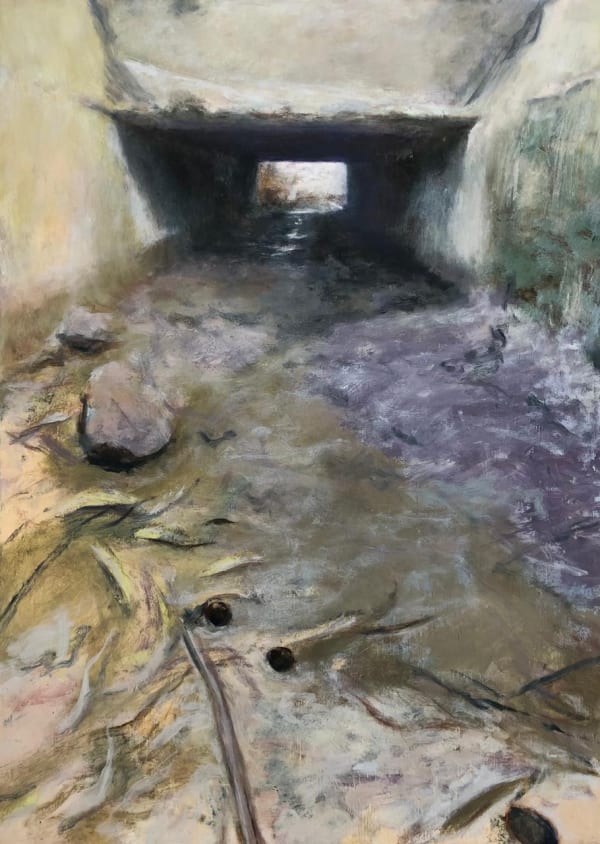-
-
Q: You started out as a sign writer and then later became an artist. What inspired the career shift?
A: I still paint a few signs. An old school sign writer is a painter and it has been a natural progression for me to arrive at the easel of oil painting. The market for hand painted signs dropped off dramatically as sign-making technology improved and I preferred not to follow that path forward so I turned to painting pictures with sign writing paint and I made some really nice paintings. I discovered quickly that trading in paintings from one's own mind is a very difficult market. A good challenge. Sign writing has been very good training in the use of paint and learning from the many creative skills that surround the trades. I slowly accumulated techniques and philosophies that enabled me to produce pictures personal to myself and my thoughts. This takes time, to improve observation capabilities, primarily a viewer myself, fascinated by the marks made by man that are so profoundly revealing of the condition of man.
-
Q: There is a series in which you paint from the perspective of being in a tunnel. Would you say that your work aligns with having “tunnel vision” or the saying “light at the end of tunnel”?A: The reality of the confinement of the canal, within a system, with one option and that is to go towards the light. Change requires us to transition, to let go of where we have come from in order to achieve the future, the moment before birth.
Q: I read that your series on tunnels is a visual “approach the philosophy of in between, the unseen destinations along the way, object and non object, gateways to other habitats.” Can you please elaborate on this?A: Duplicity – Liminal – Limbic. The paradox in the in-between. Transience is beyond capture. The thresholds of mind and matter, thought and instinct. Transformation. It’s not waiting for you to understand. -
Q: You depict many different scenes and people through painting. What then would you say is your subject matter?A: I study how light defines all that we see and make notes and interpretations of this view in paint. I choose subject matter that interests me so I can study the subject at the same time. For every painting that ends up in the public domain, there are many paintings inspired by a variety of subjects that surround it. These paintings are stored, painted over or discarded. With the tunnels I was attracted to the bright end of the tunnel surrounded by the dark interior, and as the project developed I started understanding a lot about what is in the shadows.
-

-
Q: There are artwork series in which you paint abandoned buildings. Can you explain why you are drawn to urban places that are left behind and forgotten?A: And those being built or modified. Perhaps in time they will be encountered in another setting than where we find them now. There is a dystopian fascination that is stark and emotive in that way. There is a lot happening on these sites, not only in terms of paint ability but what human activities are taking place here.Q: I read that these particular works of abandoned buildings you have described as being an interplay between shadow, light and reflection. Can you please elaborate on that?A: I observe how intense light seemingly disintegrates solid form, the deep unknowable shadows and surprising reflections, which definitely asks questions of what we perceive as reality.
Q: Abandoned spaces in South Africa in particular often invoke a sense of fear or darkness, yet your paintings diverge from this sensation, giving the illusion of peace and stillness. Would you say that this was your intention with this body of work?A: I find a peaceful stillness when I am investigating these spaces, hunting for the scenes that I like, looking at the signs of human activity, animal activity, nature’s activity, the activity of light and shadow, tone and colour, shapes and perspectives, points of view. Some of these places are remote, uninhabited and dangerous, showing the signs and marks of this activity, reflecting attitudes of parts of human culture. I feel an alert anticipation in this moment of in between, there is potential, there is evidence of something that could be both in the past and in the future. The point of weightlessness at the top of the parabola, the moment before change. -

-
Q: You reside in the Western Cape, which is increasingly encountering an influx of Western digital nomads. Would you say that your work comments on the increasing gentrification and spatial inequality in the city of Cape Town?A: Spaces are changing, people are changing, the world is modifying, these are uncertain times, as always. I am painting part of the archaeology of that.






